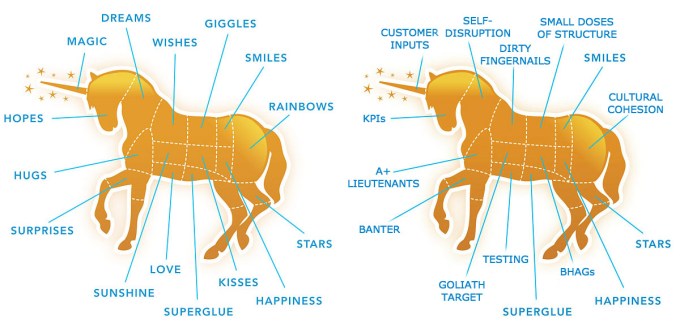Editor’s note: Jim Herbold is the chief revenue officer at Infer.
Have you ever heard of a Silicon Valley unicorn? I rode one with Box for a number of years, and I’m so proud that my startup unicorn made it past the gates of the IPO with flying colors. Box’s exciting milestone (and my new start at Infer) have led me to reflect on the mindsets, strategies and playbooks that are most important when setting the stage for unicorn-like rapid growth.
To organize my thoughts about driving hyper-growth, I hacked the image at left below. Gone are the following cuts of unicorn meat: magic, wishes, giggles, rainbows, kisses, sunshine, surprises, hugs and hope. My new and improved creature (at right below) starts with the horn, the most special and integral part of the beast:

Original image on the left (“Canned unicorn meat” from ThinkGeek) reimagined on the right.
Customer Inputs
If your company is small but you have a great product and a significant addressable market, that’s great. But now you have to watch out for Geoffrey Moore and his chasm. Your early buyers are probably nothing like your later-stage buyers. You need all of your customer-facing agents to distill prospect and customer imperatives, and you should use those to influence your selling process, pricing, messaging and product. Be sure to listen attentively to the companies that seem pretty far out, and let them tell you what you could build that they might eventually pay for.
I hired two enterprise reps very early at Box and we realized quickly that our product was not ready for adoption by IT in larger companies. But I was able to contribute a long string of inputs into our product roadmap, helping to create sustainable competitive advantage and eventually an IPO outcome. We did that by listening to (non)-buyers we knew we wanted to delight in the future. There’s often more to learn in your losses than your wins in the early days of company building.
Self-Disruption
If you have ever worked for me you’ve probably heard me say this a hundred times: if we are doing things in six months like we are doing them today, we are doomed for failure. Many people are naturally drawn to simplification, process and repetition, and I’m sure most are good, smart people and hard workers. But you should actively try not to hire them early in a startup.
There are boatloads of relatively smart and cheap venture dollars looking for a home out there, the pace of technological innovation is accelerating, and buyers and their buying cycles are way smarter and way nimble. Your venture-funded competition is rapidly evolving, trying to steal your employees and your revenue.
The only way to avoid a descent into irrelevance is to constantly reinvent yourself and your company. There can be no sacred cows – not with your people, not with your product, not with your vision or your goals. Everything must be tuned and improved.
Dirty Fingernails
“Lead from the front!” is good advice. Join calls with front-line folks. Don’t skip one-on-ones. Attend ad-hoc team gatherings. Play some pranks on people. Provide deep and detailed feedback on that Google doc someone shared with you. Answer your emails quickly. Go close a deal. Go make a cold-call. Hit LinkedIn to find a referral for someone else in your company. I could go on and on.
If you let your hands get caked with mud and your fingernails always have some amount of dirt under them, you’ll gain respect. Your team will actually believe that you are part of their team, which is what really counts in leadership.
Small Doses of Structure
Formal education is great, but experience is the very best teacher. Pattern recognition is a wonderful thing and it allows for timeliness, clear communication and confidence. I went from a sales team of myself to nearly 400 folks in my last gig. I tested and implemented pretty much every different go-to-market motion you can think of and made nearly all of them work. So I could say I’ve got a playbook now.
But trying to put playbook-derived end-game structures in place too early does not allow for iteration. Without step-by-step iteration, you might lose the ability to read where or why or how something went sideways. Your team’s spider-sense of being handed too much change will activate. Keep your playbook bible on the side for occasional reference only.
Cultural Cohesion
As your company finds some amount of success, things will get complicated. You’ll need to find the right balance of hiring talent and experience from the outside and promoting enough from within. You’ll have VPs reporting to VPs, and your direct reports will make more than you sometimes. Your team will be tempted by a never-relenting army of dreaded recruiters. Your company will likely struggle to maintain patience (Rome was not built in a day) and understand when to say no. How do you avoid the messes all of these challenges create?
Well, winning and success help a lot. But so does having simple and clear company-level cultural caveats that provide a north star for ethics, behavior and effort. Making these statements public and invoking them with regularity makes them stick. If teams define their own cultural islands, it will be hard to align everyone’s efforts. Goal setting will get screwy, dependencies will dog you, targets will be missed, and customers will be left confused by your company’s multiple personalities.
BHAGs
My last CEO was a master of the BHAG, or big hairy audacious goal. We spoke about planting our service in every company in the world, we openly discussed how and when we would hit one billion in annual recurring revenue (when we were at just $8 million ARR), and we believed we would surely be the next great enterprise software company. Every time we beat our sales goals, he was ready with his ratchet-up. We got used to it. We built confidence that there was no deal we could not take down.
How do you climb Mt. Everest? One foot in front of the other, one step at a time. Keep at it and you will get to the top. (Or not, such is life. Try again.) It’s okay to talk about BHAGs in terms of faith and belief, and I actually found this to be increasingly effective as my team got into the hundreds. That said, calling out the smaller wins and letting people feel good about them is the best way to instill confidence in your team early on. Celebrate the little victories.
Testing
You are not as smart as you think you are. Sorry, but it’s true for all of us. Trying to diversify your go-to-market strategy? I suggest hiring a team of two to make an initial foray and asking them to tell you what is and is not working. Arguing with your product-centric CEO about the viability of a new feature? Run the idea by some customers. Wondering if your sign-up form can produce the same number of leads if you add another field? Your answer is an A/B test. Let the machines learn for you and let the data speak. Nothing beats having objective, data-derived truth vs. hunch-based arguments that never end.
A Goliath Opponent
I met a really smart fellow before he became the COO of a unicorn company that went public last year. He was talking to me about his job search and pulled out his laptop. He showed me an extensive spreadsheet he had created to measure what he called the “disruption quotient” for each of the companies he was considering. Disruption is a glorious concept. It’s all about attacking the soft underbelly of a giant with a blunt stick or taking potshots at an incumbent vendor that has lost its ability to innovate quickly.
Slaying a big dragon can be profitable, immensely fun and effective, and a crucial strategic component to creating a unicorn. Even just making statements that you intend to slay a big dragon will get noticed.
The value of this approach is that buyers will have a frame of reference to better understand what you intend to be when you grow up. They may say you are nowhere close to delivering what Goliath can, but rapid innovation and agile engineering and relentless feature releases are hard to ignore, especially if you’re charging pennies on the Goliath’s dollar.
Banter
Most people are social critters. If your sales floor or marketing team is deathly quiet, especially early, you probably have a fatal problem. When you put a group of smart, hungry people into a company, you need to foster regular, energetic conversation. No idea should be off-limits, no question off-base. You and your team are inventors, and building a company is largely a creative exercise.
Let your team try stuff that comes out of the banter – I promise some of their crazy ideas will work. Most importantly, stay really close to that banter yourself. Hierarchy counts for very little or next to nothing while you are in the early days of figuring things out. People need to have a voice and be heard.
(Only) A+ Lieutenants
Hiring people who are smarter and more experienced than you requires a rare lack of ego. Concern for title layering or “fair” compensation is just distracting noise. It’s pure magic to bring in people with different but complementary skills and personality traits from your own. You will learn a ton from them, they will deliver, and your life will get easier because delegation is way more viable. Plus, they will make you look great in the eyes of your CEO and board. All you need to do is hire the best and shine a bright light on the hard work and achievements of your awesome team.
KPIs
There’s a certain beauty in the rigor of data. Trend analysis of crucial and varied key performance indicators is an acquired skill that’s one of the most important traits of a unicorn operator. Establish your KPIs early, and instrument your systems to track activity, attribution and results. Automate as much as you can as early as you can.
This is why it’s important to hire a sales and marketing operations team early. You have to have a group that can implement systematic and consistent testing regimes, and generate neutral and honest analysis. Sales and marketing ops is actually the most important part of the superglue cut that remained in my visual above. You cannot create sustainable growth without them.
I’ve been fortunate enough to work at five really small companies, and gained valuable experience from all of them. One stayed small. One got acquired. Another went IPO, hit $1 billion-plus valuation for a while, and eventually went bankrupt.
Hyper–growth and scalability is part science for sure, but there’s a lot of art, as well. There will be pivots and resets, jump-starts that fizzle, and surprises that you never expected.
